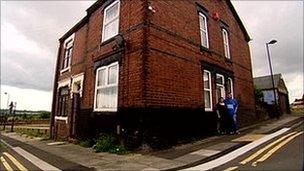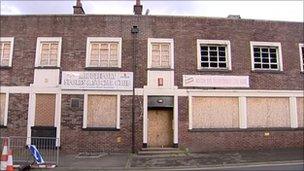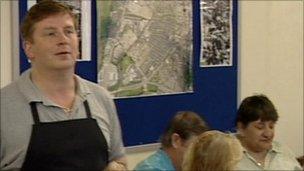Stoke suffers de-generation after homes scheme collapse
- Published
- comments
Pauline Kerry and Barbara Bereton live on Newport Lane in Middleport, Stoke-on-Trent. Nobody else does. Their semi-detached homes, side by side, are the last ones standing after the council demolished the rest of it.
Stoke, once an industrial heartland, has had its heart ripped out. Hundreds of terraced houses have been demolished; hundreds more stand derelict; a few remain inhabited, their backyard gnomes and rose trees defiant among the burnt-out mattresses and crumbling brickwork.
All this has happened because a scheme called Pathfinder went wrong and has been cancelled. Twelve towns and cities across the Midlands and the north of England are suffering as a result.
Pauline and Barbara take me to the wasteland at the back - neat mounds covered in poppies and thistles demarcate where the walls of terraces used to stand.
Street after street has gone - the only noise is the jerky gear-changing of learner drivers, for whom this deserted grid-pattern is ideal.

Pauline and Barbara remember a thriving community in Middleport, which has now disappeared
"We had a community," says Barbara, "a butcher, a grocer, the club". The club stands charred and gutted at the end of the street. "That house there, I grew up in, and so did my mother." Its roof is a skeleton of bare beams.
The place is now a neat, floral hole in the middle of a major British city and it is not the only one.
It was Labour's then-deputy prime minister John Prescott who launched Pathfinder in 2003. The original £2.2bn plan was to demolish 90,000 terraces nationwide, renovate thousands more, and revive the housing market in places that were missing out on the property boom.
It was overt social engineering - the "social mix" would change as the terraces, often lived in by elderly working class people who had been there, like Barbara, all their lives were replaced by "mixed use".
The aim was not just physical renewal, it was to stimulate housing demand in the poor industrial areas. And since supply affects price, bulldozing the supply of terraces, which it was repeatedly argued "nobody likes", was the solution.
Controversial scheme
In Hanley, just down the road, you can see what it should have looked like, had it worked. The "City Waterside" quarter, as it is now called, has new homes on the waterside, including some residents re-housed from Hanley's terraces, which have been similarly flattened.
But Pathfinder was hugely controversial - in 2006 David Cameron called it "baffling". CABE, the urban design watchdog repeatedly criticised the newbuild designs. There were repeated accusations of waste and featherbedding among the "super-quangos" in charge.
In 2007 National Audit Office described the whole project as "high risk", adding: "While there have been physical improvements in some neighbourhoods, it is unclear whether intervention itself has led to improvement in the problems of low demand."

Residents who have been left behind find they are unable to move
Last October, in the Spending Review, the government scrapped Pathfinder. It has devolved the task of finishing or winding up the schemes to local level - Local Enterprise Partnerships and local councils, who will have to find the money from a variety of other funding streams. It has provided £30m, which councils must bid for, to meet the costs of winding the scheme up.
This, say Stoke's residents, has left them high and dry.
Brendan Nevin, a housing expert who helped implement the scheme at national level, guided me around some of the housing that is in limbo.
We walked down a back alley. There was evidence of arson, nine-tenths of the homes are abandoned, and because of neglect and subsidence the brickwork is looking very temporary on some of them. But there are still people trying to live here:
"There's no money to buy people out, it was cut on April 1st. So they can't demolish; clearance zones are dangerous and need to be got down as soon as possible," Mr Nevin said.
Break from the norm
Mr Nevin believes the coalition's decision to cancel the scheme half finished is a break with 70 years of post-War practice on housing policy:
"We have no Plan B, no guidance, we've been left to our own devices with the money being pulled at very short notice.
"There was always consensus between parties that you had to finish things that had started, even if the policy changed; there was a consensus that no place would be left to die; no place where the market would not work; now we are letting places live or die by the market and this is a massive change."

The local shops are now boarded up
It is stunning to find that people have been moved out - sometimes forcibly - without any concrete guarantee that the rebuild will happen, but this is the situation in Stoke. The original Pathfinder agreement between the government and local councils, seen by Newsnight, says:
"The Participating Authorities shall: (i) use all reasonable endeavours to ensure that the Pathfinder is not discontinued or disbanded."
Instead of new build, in large parts of Hanley's "City Waterside" there are just poppy fields with low fences marking where the exterior walls once stood. Swallows swoop over it all but it is not idyllic.
The long closed Lord Nelson pottery at the canal side is now boarded up. Even the "second growth" industries - the Karate gyms, taxi-firm HQs, scrap yards etc - are leaving the area.
Mr Nevin describes such private sector jobs as are available here as "Third World".
Reasons for failure
The council employed a community worker to keep things together in the face of such dramatic change. Some of the local residents opposed the scheme, others were always going to need help to get through it.
Now, Lee Carroll, the community worker, is facing redundancy as the money has run out. I meet him as he hugs the local residents, one by one, as the last bingo session finishes.
"Personally I think we should have taken a section, demolished and rebuilt; a decant process - build and move - but we didn't and that's where it's gone wrong. So people are stuck and it's split the community."
The scheme was always controversial - its opponents accused it of lavishing money into Labour heartlands, of social "cleansing", even a covert attempt to abolish the traditional working class community.

Community worker Lee Carroll is facing redundancy as the money to fund his post has run out
Others focused on allegations of waste and poor design, a core criticism - shared by David Cameron himself - was that demolition was a wasteful strategy. As a result of lessons learned during the course of the scheme the demolition aspect was scaled back, to 51,000 homes.
However, in cancelling the scheme the coalition has left people across the Pathfinder areas with a major problem. Some have turned to legal action, external, threatening a local authority on Merseyside with "blight" notices.
The Audit Commission's final strategic report on the scheme found some successes nationally - Pathfinder leveraged in a lot more public and private money than ordinary housing renewal schemes.
But it was up against two inexorable forces: a housing boom and bust, which has left homes in the affected areas very difficult to sell; and de-industrialisation - the basic problem that underlay everything - which has seen the population of the Stoke Pathfinder area actually decline even as the rest of the Midlands' population has boomed.
On Middleport the Commission says, external:
"Further intervention is needed to progress sales and to restore both private and corporate investor confidence. There is also a need to complete clearance area work in the AMI, for which funding will be needed to meet commitments made to residents."
The graffiti on the walls says something more direct: "Big Society? Not in Stoke-on-Trent, evidently."
There is a mixture of views among those I talk to. Some put it down to Labour's incompetence, its failure to listen to local people in the design of the scheme. Others believe the coalition has no interest in what happens to people in the blighted areas of the Midlands and the north of England.
Pauline Kerry sums the situation bluntly: "We've been de-generated."